Did you know that even in low-light homes, you can create thriving green spaces with sustainable terrariums? Let’s explore how to transform everyday items into eco-friendly mini ecosystems. Using recycled materials like glass jars or old bottles, you can build designs such as a 6-inch tall Glass Jar Miniature Forest or a 10-inch Recycled Bottle Tropical Escape. Stick around to uncover step-by-step guides for crafting these unique setups.
Contents
Glass Jar Miniature Forest
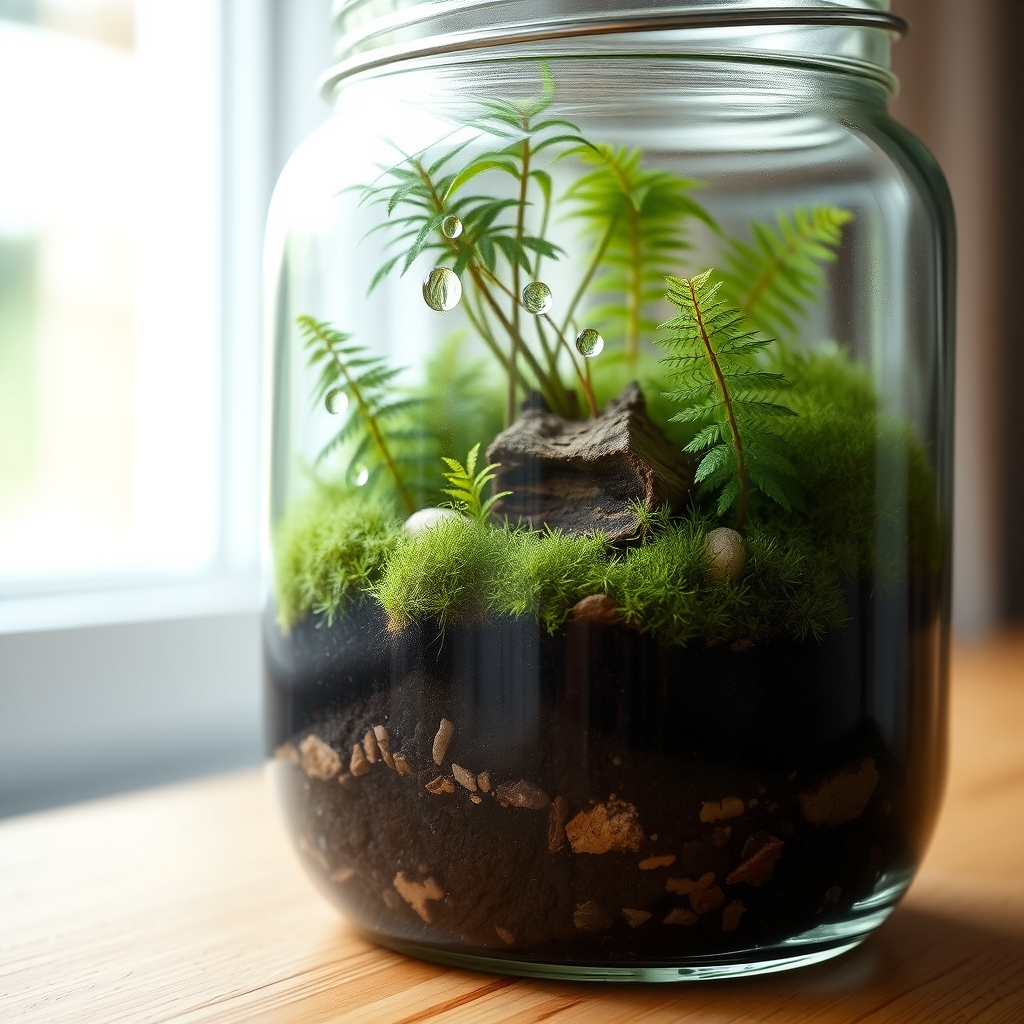
A glass jar miniature forest is a charming and accessible way to create a sustainable terrarium, especially for low light homes. This design involves transforming a simple glass jar into a tiny, self-contained ecosystem that mimics a forest environment. Using a clear glass jar with a lid, you can house small plants like mosses, ferns, and air plants that thrive in low light and high humidity, making them ideal for indoor spaces with limited natural sunlight.
To create this miniature forest, start by layering the bottom of the jar with pebbles or gravel for drainage, followed by a thin layer of activated charcoal to prevent mold and odors. Add a substrate of potting soil mixed with sphagnum moss to retain moisture, then carefully plant your chosen low-light plants. Decorative elements like small rocks, twigs, or miniature figurines can enhance the forest aesthetic, while the sealed lid helps maintain humidity, reducing the need for frequent watering.
This design is not only low-maintenance but also a creative way to bring a piece of nature indoors. The enclosed environment of the glass jar helps sustain the plants with minimal care, making it perfect for beginners or those with busy lifestyles. Placed on a shelf or desk, a glass jar miniature forest adds a touch of greenery to any dimly lit space without requiring intense light or upkeep.
Recycled Bottle Tropical Escape
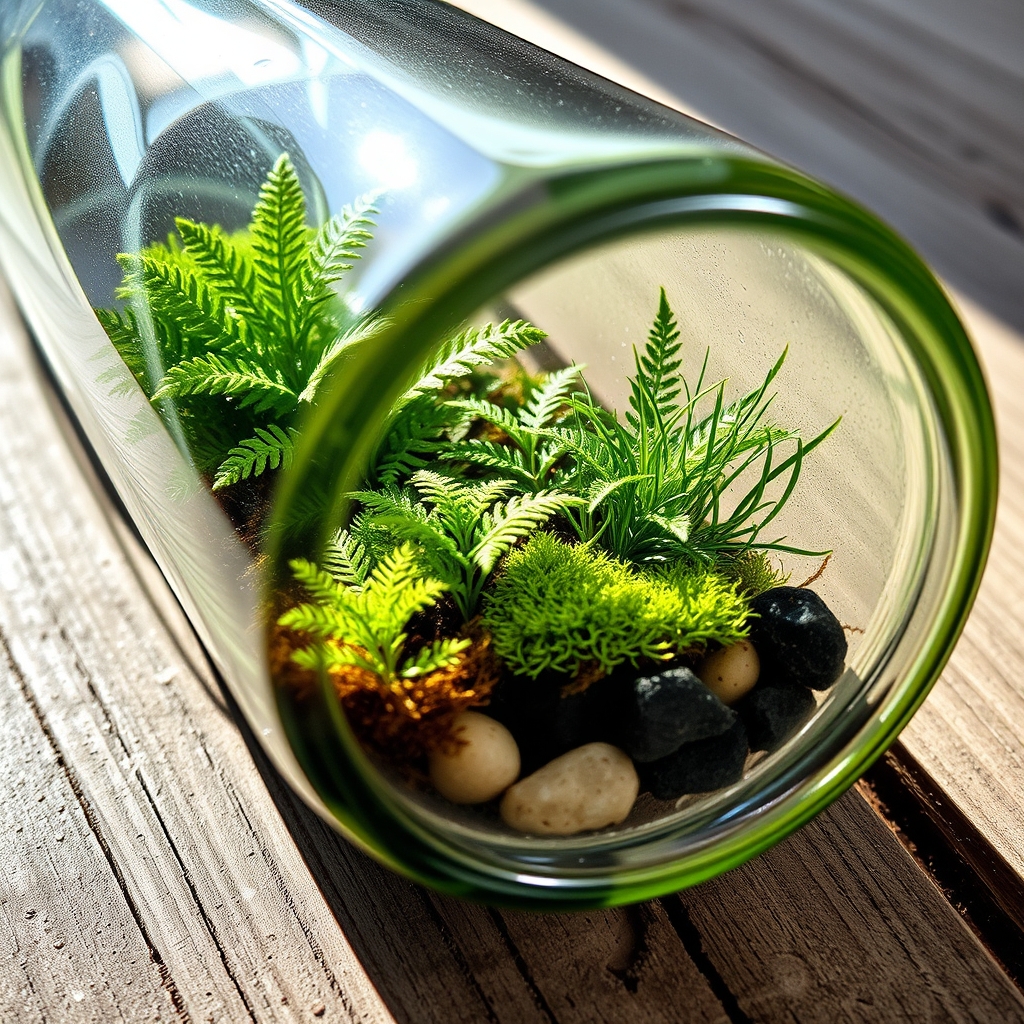
The Recycled Bottle Tropical Escape is a creative and sustainable terrarium design perfect for low light homes. This concept transforms used plastic or glass bottles into miniature tropical ecosystems, offering a unique way to repurpose household waste. By cutting the top off a bottle and using it as a lid or simply leaving it open, you can create a small, enclosed environment that mimics the humid, lush conditions of a tropical rainforest, ideal for plants like ferns, mosses, and small-leafed ivy that thrive in low light and high moisture.
To build this terrarium, start with a clean, dry bottle and layer the bottom with pebbles or small rocks for drainage, followed by a thin layer of activated charcoal to prevent mold and odors. Add a substrate of potting soil mixed with sphagnum moss to retain moisture, then plant your chosen tropical species, ensuring they are small enough to fit comfortably within the bottle’s confines. Mist the plants regularly to maintain humidity, and place the terrarium in a spot with indirect light to avoid overheating, making it a low-maintenance and eco-friendly decor piece for dimly lit spaces.
This design not only promotes sustainability by reusing materials but also brings a touch of nature into urban or light-limited environments. The transparency of the bottle allows for easy observation of the plants’ growth, turning a simple recycled item into a fascinating display of greenery. It’s an accessible project for beginners and a delightful way to experiment with micro-ecosystems at home.
Mason Jar Moss Haven
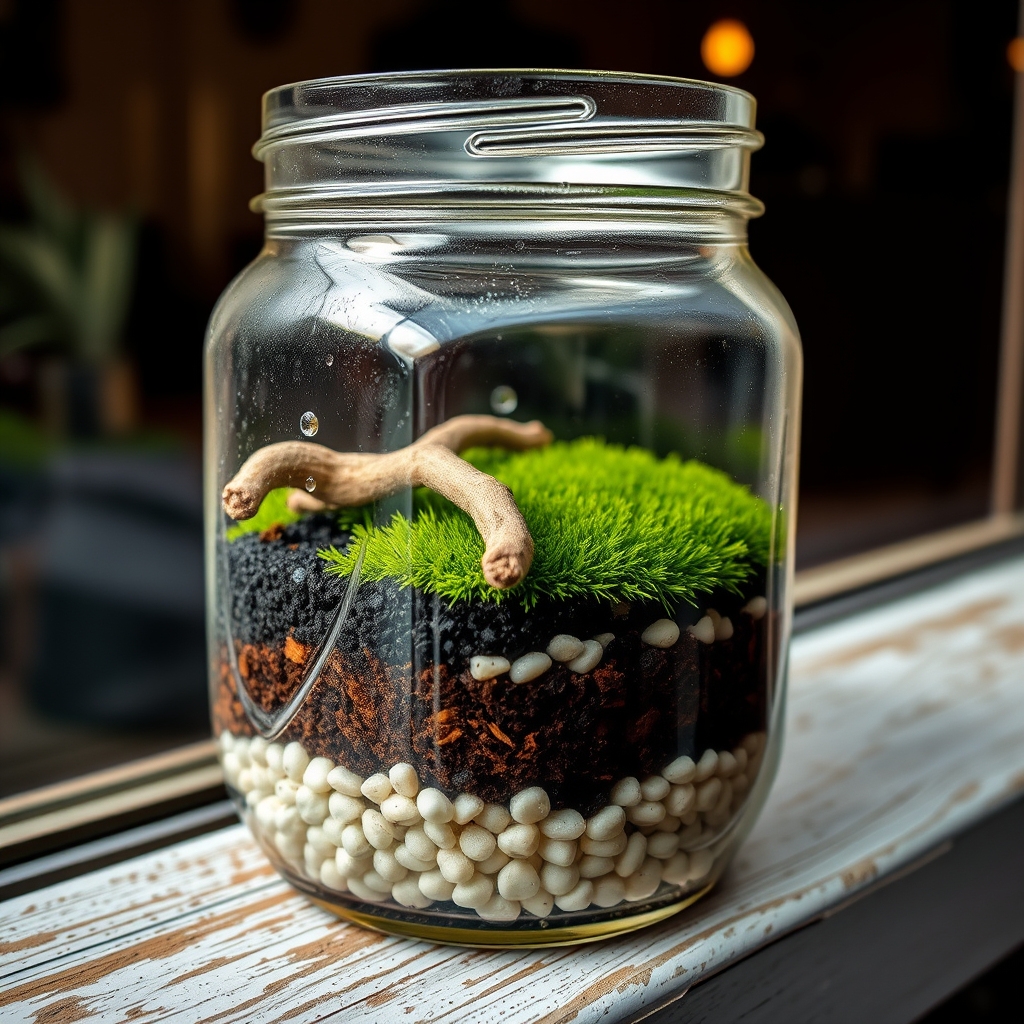
The Mason Jar Moss Haven is a simple yet charming terrarium design perfect for low light homes. Utilizing a common mason jar, this setup transforms an everyday item into a miniature green oasis. Moss, which thrives in low light and high humidity, is the ideal plant choice for this enclosed environment, requiring minimal care while adding a lush, natural touch to any space.
To create a Mason Jar Moss Haven, start with a clean, dry mason jar and layer the bottom with small pebbles or gravel for drainage. Add a thin layer of activated charcoal to keep the environment fresh, followed by a substrate of potting soil or sphagnum moss. Place small clumps of moss—such as sheet moss or cushion moss—on top, pressing them gently into the substrate, and mist lightly with water before sealing the jar. The lid helps maintain humidity, mimicking the moss’s natural habitat.
This design is not only low-maintenance but also highly customizable. You can add tiny figurines, rocks, or driftwood to create a whimsical scene within the jar. Positioned on a shelf or desk in a low light area, the Mason Jar Moss Haven brings a touch of nature indoors without the need for intense sunlight or frequent upkeep.
Vintage Teacup Fern Nook

The Vintage Teacup Fern Nook is a charming and creative terrarium design tailored for low-light homes, utilizing repurposed vintage teacups as miniature ecosystems. This concept transforms delicate, often unused teacups into thriving homes for small ferns or mosses that thrive in shaded environments. The teacups, with their intricate designs and nostalgic appeal, add a touch of whimsy and personality to any corner of a home, making them perfect for small spaces like windowsills or shadowy nooks.
To create this terrarium, start by layering the bottom of the teacup with small pebbles for drainage, followed by a thin layer of activated charcoal to prevent mold and odors. Add a layer of potting soil suitable for ferns, then plant a tiny fern or a patch of moss, ensuring it fits snugly within the cup’s dimensions. These plants are ideal for low-light conditions, requiring minimal sunlight and thriving in the humid, enclosed environment of the teacup, which helps retain moisture.
This design not only recycles vintage items but also brings a sustainable, green element into homes with limited natural light. The Vintage Teacup Fern Nook is low-maintenance, needing only occasional misting to keep the soil damp and a spot away from direct sunlight to prevent overheating. It’s an elegant solution for plant lovers looking to incorporate greenery into their decor without the need for bright, sunny spaces.
Upcycled Tin Can Jungle

The Upcycled Tin Can Jungle is a creative and sustainable terrarium design perfect for low light homes. This concept involves repurposing used tin cans—such as those from soup, vegetables, or coffee—into small, self-contained ecosystems. By transforming everyday waste into functional decor, this design not only reduces household waste but also adds a rustic, industrial charm to indoor spaces. The tin cans are ideal for housing small, shade-tolerant plants like ferns, mosses, or miniature pothos, which thrive in the limited light conditions often found in apartments or homes with few windows.
To create an Upcycled Tin Can Jungle, start by thoroughly cleaning and drying the cans to prevent rust or mold. Add a layer of small pebbles or gravel at the bottom for drainage, followed by a thin layer of activated charcoal to keep the environment fresh. Then, fill with a suitable potting mix and plant your chosen low-light flora. The compact size of tin cans makes them easy to place on windowsills, shelves, or desks, even in cramped spaces. For added personalization, you can paint the cans or wrap them in twine or fabric to match your home’s aesthetic, turning a simple recycling project into a stylish green statement.
Wooden Box Shade Garden
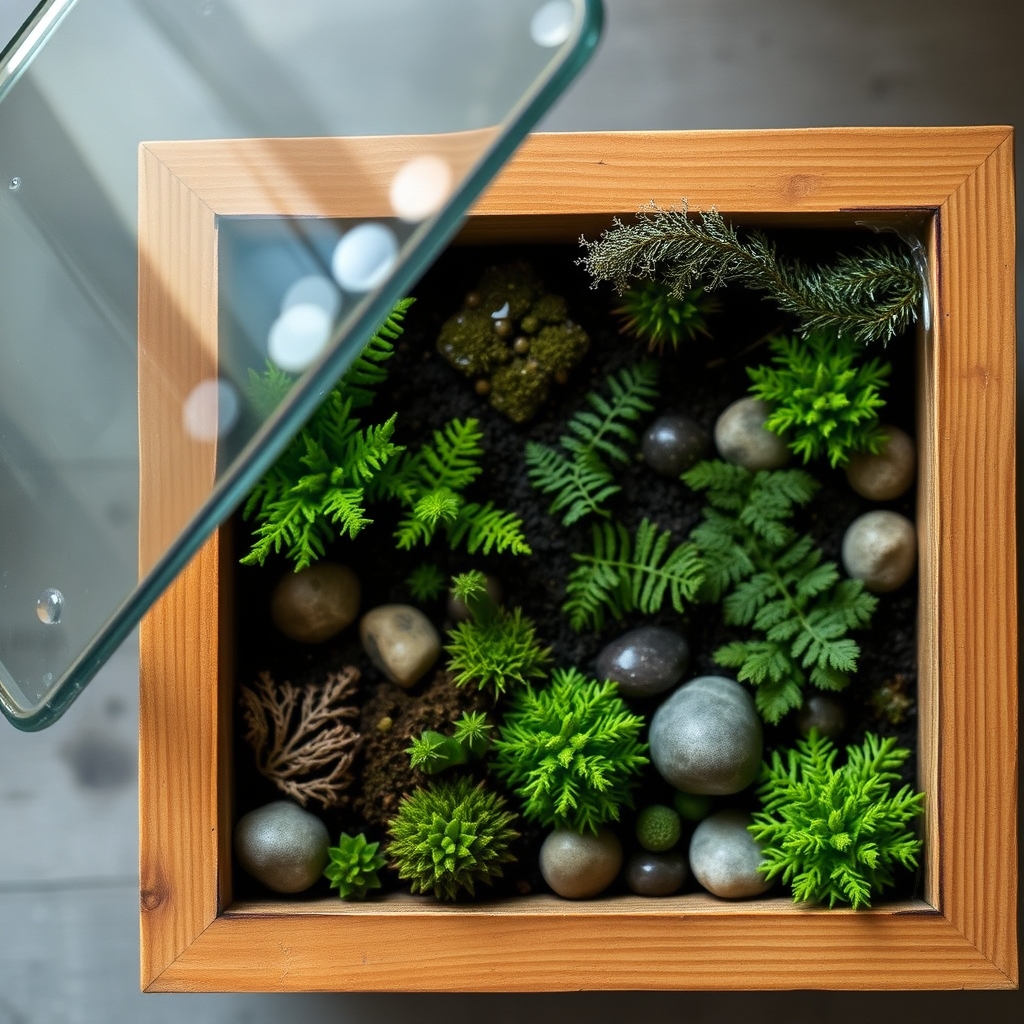
A Wooden Box Shade Garden is an innovative and aesthetically pleasing terrarium design tailored for low-light homes. This concept utilizes a wooden box as the primary structure, often with a glass or clear acrylic lid to allow minimal light to filter through while maintaining a controlled environment. The wooden frame not only adds a rustic charm to the setup but also provides sturdy support for shade-loving plants that thrive in dim conditions, such as ferns, mosses, and certain types of ivy. This design is ideal for spaces like basements or north-facing rooms where natural light is limited.
To create a Wooden Box Shade Garden, start by selecting a wooden box with drainage holes or adding a layer of pebbles at the bottom to prevent waterlogging. Line the box with a breathable fabric or moss to retain moisture while allowing excess water to escape. Then, add a substrate suitable for shade plants, followed by carefully arranging the plants to mimic a natural forest floor. The glass lid can be partially opened for ventilation, ensuring the humidity levels remain ideal without promoting mold growth. This terrarium design not only brings greenery into low-light spaces but also serves as a unique decorative piece that blends seamlessly with various interior styles.
Hanging Orb Lush Sphere
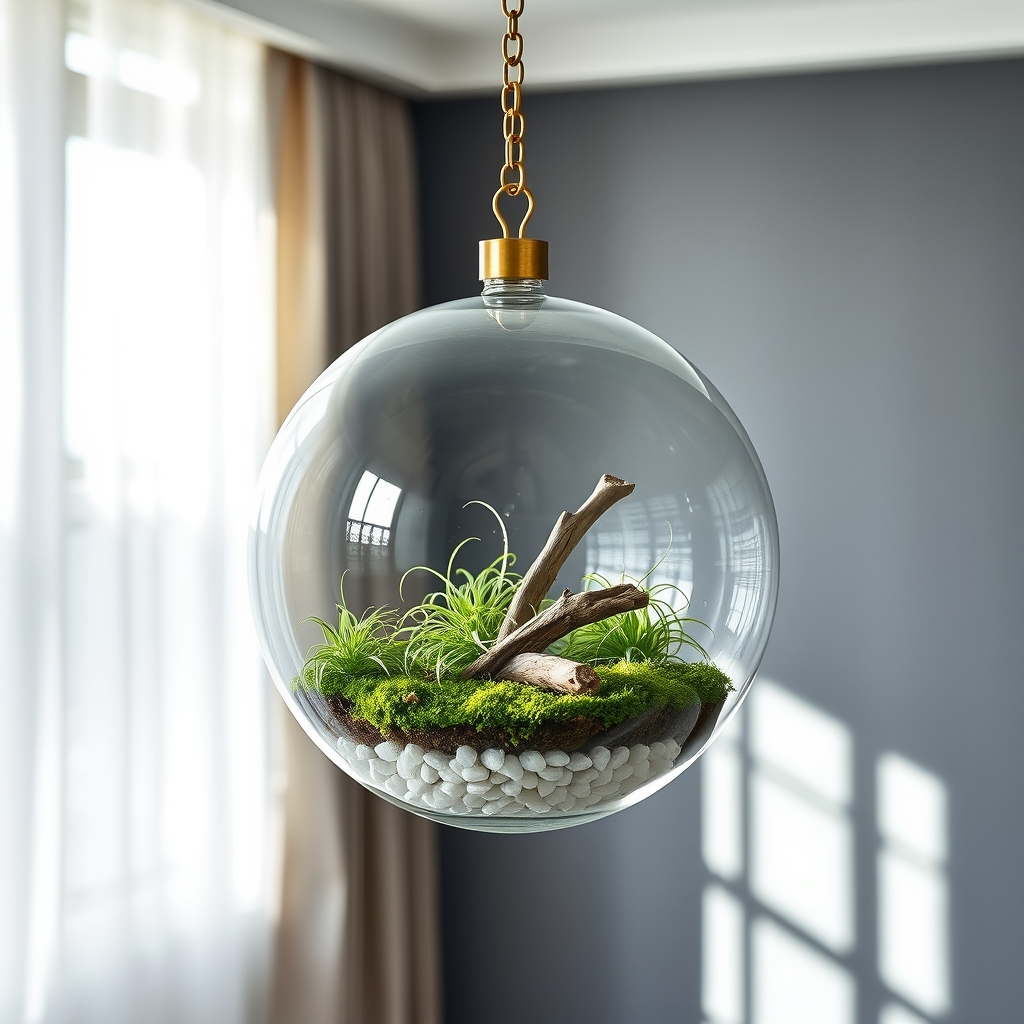
The Hanging Orb Lush Sphere is an innovative and stylish terrarium design perfect for low light homes. This spherical glass container is suspended from the ceiling, creating a mesmerizing focal point in any room while maximizing space efficiency. Its design allows for a 360-degree view of the enclosed miniature ecosystem, making it an eye-catching piece of living art that thrives even in dim conditions.
Ideal for small spaces or apartments with limited natural light, the Hanging Orb Lush Sphere is typically filled with low-maintenance, shade-loving plants such as ferns, mosses, and air plants. These plants require minimal sunlight and can flourish under artificial or indirect light, making them perfect for this setup. The enclosed environment of the orb helps maintain humidity, reducing the need for frequent watering and care.
To enhance its aesthetic appeal, the orb can be customized with decorative elements like small pebbles, driftwood, or tiny figurines, creating a personalized micro-landscape. Easy to install with a sturdy hanging mechanism, this terrarium design not only brings greenery into low light spaces but also adds a modern, artistic touch to home decor.
Repurposed Lamp Base Oasis
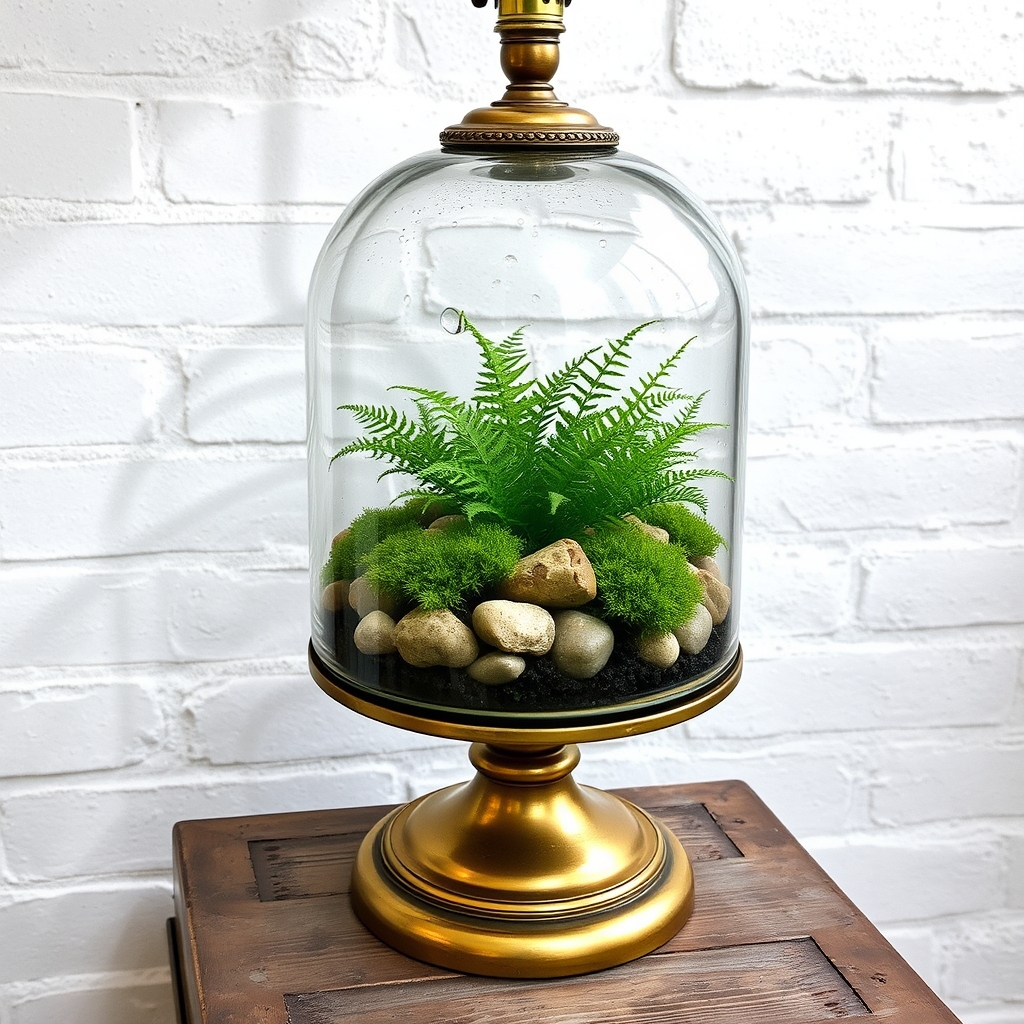
The Repurposed Lamp Base Oasis is a creative and sustainable terrarium design ideal for low light homes. This concept involves transforming an old or unused lamp base into a unique terrarium container. By removing the electrical components and ensuring the base is watertight, it can be repurposed into a small ecosystem for shade-loving plants like ferns, mosses, or small-leafed ivy. This approach not only recycles an item that might otherwise be discarded but also adds a quirky, vintage aesthetic to your home decor.
To create this oasis, start by selecting a lamp base with a wide, stable bottom or an enclosed glass or metal structure that can hold soil and plants. Add a layer of pebbles for drainage, followed by activated charcoal to prevent mold, and then a suitable potting mix for your chosen plants. The limited light in many homes makes this design particularly fitting, as the enclosed or semi-enclosed nature of a lamp base can help retain humidity, mimicking the natural conditions these plants thrive in.
This terrarium style is perfect for small spaces, such as apartments or dimly lit corners, where traditional gardening might not be feasible. It serves as a conversation piece while promoting sustainability through upcycling. With minimal care, such as occasional misting and ensuring indirect light, a Repurposed Lamp Base Oasis can bring a touch of greenery to even the darkest of spaces.
Corked Vial Micro Greens
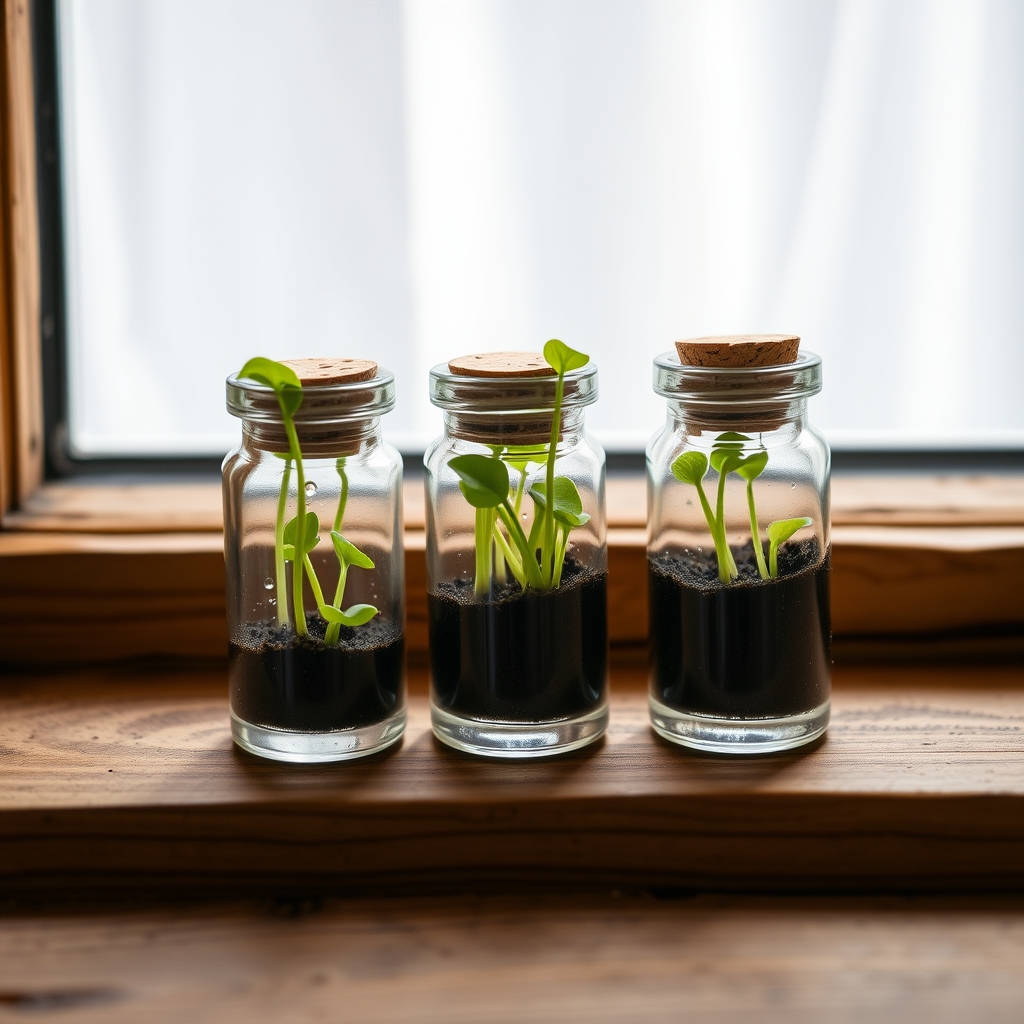
Corked vial micro greens are an innovative and space-saving way to bring greenery into low light homes. These tiny terrariums are created using small glass vials with cork stoppers, making them perfect for tight spaces like windowsills, desks, or shelves. Inside the vials, micro greens—young, edible plants harvested at an early stage—can thrive with minimal light and care, offering both aesthetic appeal and a functional mini garden.
The setup for corked vial micro greens is simple and requires only a few materials: a glass vial, a cork stopper, a small amount of soil or a growing medium, and micro green seeds such as arugula, radish, or mustard. The enclosed environment helps retain moisture, reducing the need for frequent watering, while the cork allows for slight air circulation to prevent mold. Even in low light conditions, many micro greens can grow successfully with indirect sunlight or a small grow light, making them ideal for homes with limited natural light.
Beyond their practicality, corked vial micro greens add a touch of charm to any space with their delicate, vibrant sprouts. They can be customized with different seed varieties to suit personal tastes or culinary needs, providing a sustainable way to grow fresh herbs and greens year-round. This design not only enhances the decor of a low light home but also promotes a connection to nature in even the smallest of living spaces.
Bamboo Frame Verdant Corner
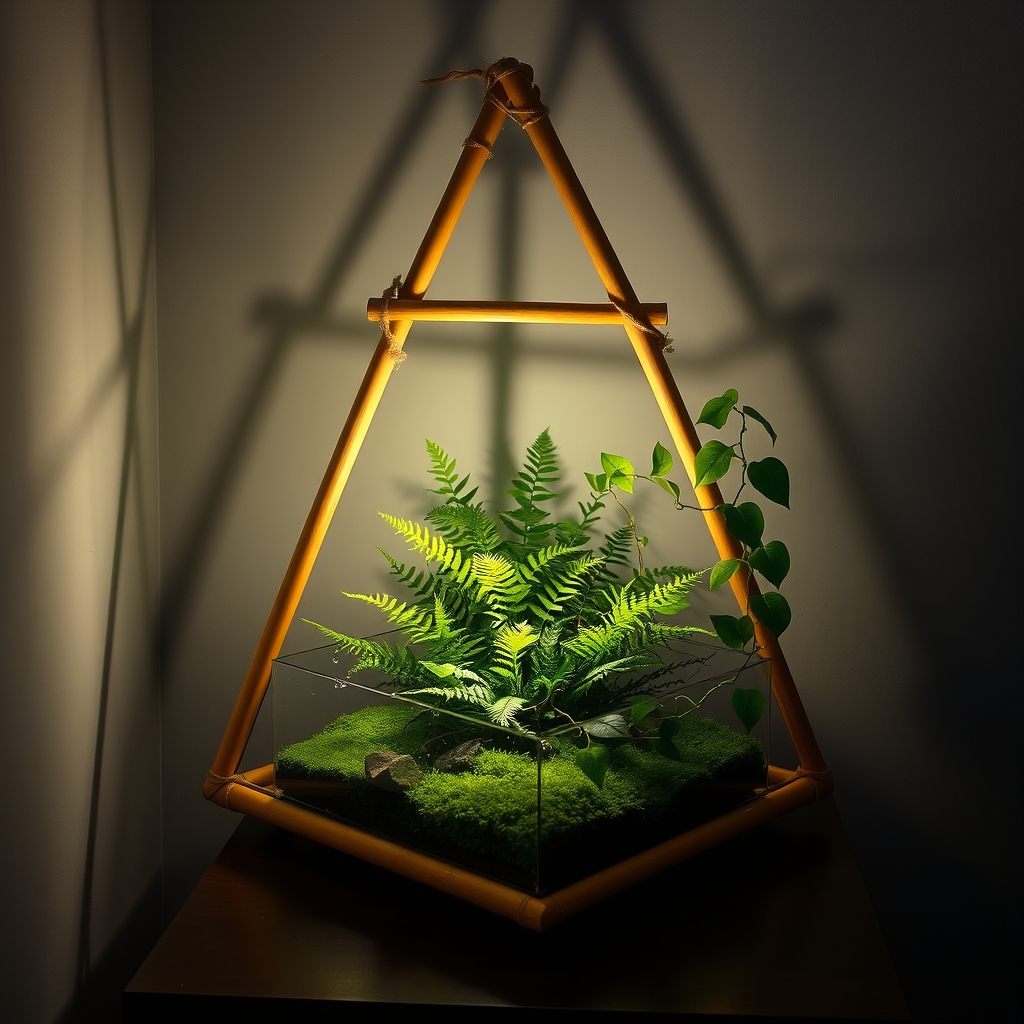
The Bamboo Frame Verdant Corner is an innovative and eco-friendly terrarium design tailored for low light homes. This design utilizes a lightweight, sustainable bamboo frame to create a compact, corner-friendly structure that maximizes space while adding a touch of natural elegance. The frame is often shaped into a triangular or rectangular form, fitting snugly into room corners, and is paired with clear glass panels to allow minimal light to penetrate and nourish the enclosed plants.
This terrarium style is ideal for housing shade-tolerant plants such as ferns, mosses, and small-leafed ivy, which thrive in low light conditions. The bamboo frame not only provides structural support but also enhances the aesthetic appeal with its warm, earthy tones, blending seamlessly with various interior decor styles. Additionally, the design often incorporates a small base tray for easy watering and humidity control, ensuring the plants remain healthy with minimal maintenance.
The Bamboo Frame Verdant Corner is a perfect choice for urban dwellers or anyone with limited natural light in their living spaces. Its sustainable materials and space-saving design make it an environmentally conscious option, while its simplicity allows for customization with decorative elements like pebbles or miniature figurines. This terrarium brings a slice of nature indoors, creating a calming, green oasis even in the dimmest of homes.
